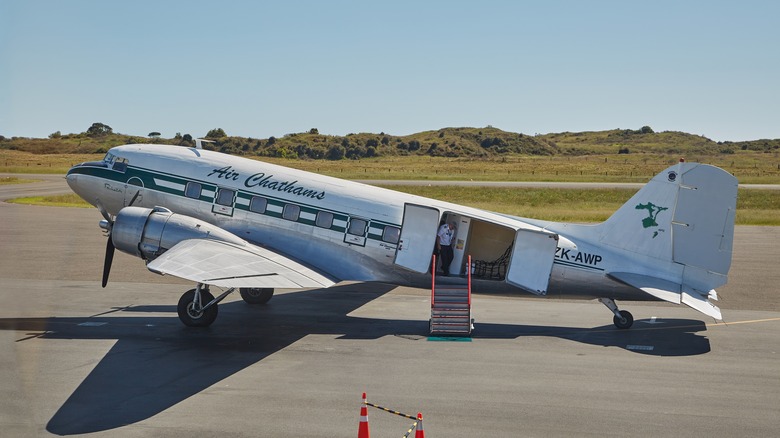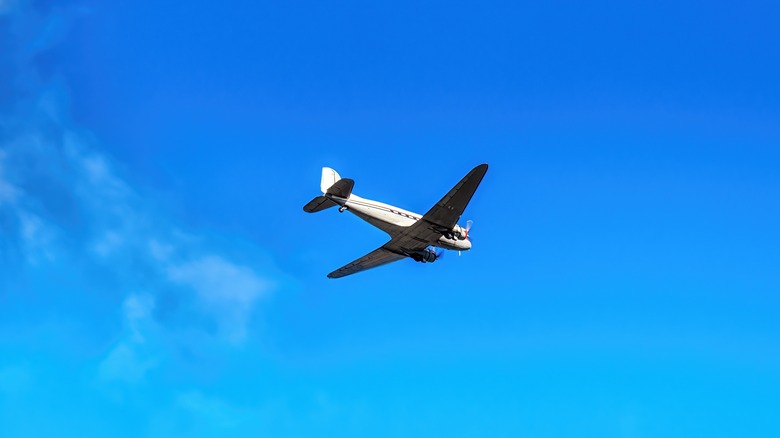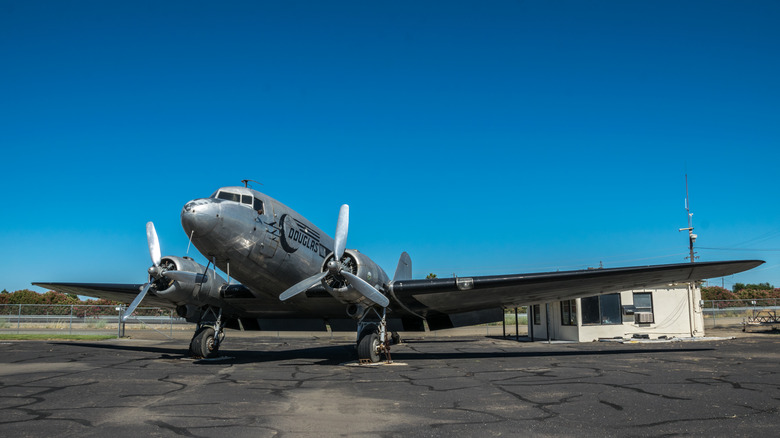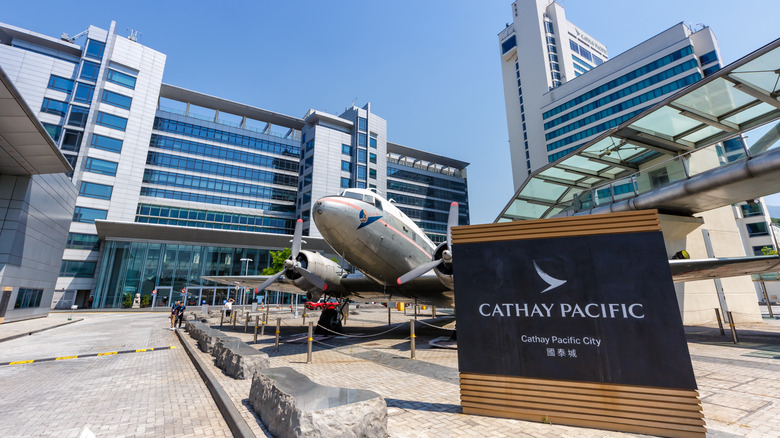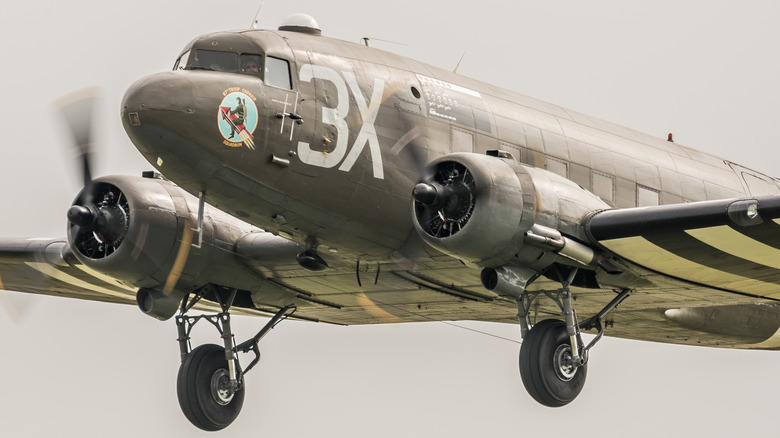Here's Why The Douglas DC-3 Is Still Flying After Almost 90 Years
The history of flight is, perhaps, one of the most astonishing stories we've ever told as a species. It's surreal to think just how fast tremendous advances in the field were made: There were approximately 66 years between the Wright Brothers' first flight and the moon landing. Almost as incredible as this is the fact that some venerable models of aircraft have been in service even longer than that.
The Douglas DC-3 is a propeller-driven aircraft, and one that was introduced into a world of aviation that is very different to the one we know today. Since it made its very first flight in 1935, the flight industry has transformed dramatically, and the DC-3 was a huge catalyst for a lot of that change.
Let's take a closer look at the aircraft, why it proved to be so important, and exactly how it has managed to remain relevant even after almost 90 years of use.
The development of the Douglas DC-3
The DC-3 was developed by Douglas Aircraft Company in the early 1930s. Boeing's 247 was really the only option for commercial flight at the time, first flown by United Air Lines in 1933, and was speedier and more reliable (thanks to its retractable landing equipment) than alternate aircraft. Douglas' goal, then, was to create a new aircraft to challenge the 247's monopoly on the industry.
It would need to be large enough to accommodate enough passengers to be a money-spinner, but not so large as to be impractical or more expensive to develop and operate. More than that, American Airlines' C.R. Smith wanted to field an aircraft that gave passengers the opportunity to travel not only conveniently, but in style.
Ticking all of these boxes was a challenging task indeed, but the DC-3 was a huge achievement. In terms of its dimensions, it may seem rather a modest aircraft: Its wingspan was 95 feet, and it measured around 64 feet in length. Its engines — dual Wright SGR-1820s — allowed it to cruise at up to around 190 mph, and by contrast, today's Airbus A380s can hit max speeds of 737 mph.
Thanks to some of its unique traits, though, this aircraft became the new standard for sophisticated air travel, and was very successful.
Comfortable aircraft adaptable to warfare
The Douglas Sleeper Transport had sleeping space for 14 passengers through magnificent folding chairs. Passengers were treated like royalty, too. Henry M. Holden notes in "The Legacy Of The DC-3," per Smithsonian Magazine, that the premium experience was intended to last the length of the flight. Travelers were offered "cocktails, followed by entrée choices such as sirloin steak or Long Island duckling, served on Syracuse China with Reed & Barton silverware," according to Holden, and the pilot would personally mingle with travelers.
A writer for Fortune took a flight to California from Newark Airport in 1938, according to Smithsonian Magazine, and commented at length on the journey aboard the aircraft. The DC-3 experience, it seems, was exceptional from the takeoff itself. The writer is quoted as stating not simply that the takeoff was comfortable, but that the plane "left the ground so smoothly that none of the first fliers in the cabin realized what had happened until they saw the whole field rushing away behind them."
In 1941, the DC-3 first demonstrated its versatility as a crucial World War II aircraft. Adapted military transport variants could carry 18 stretchers for wounded personnel, 28 soldiers, or other hardware to be airlifted. Most notably, the C-47 played a huge role in the Normandy landings, and over 10,000 of them were created during the conflict.
So many years later, the Douglas DC-3 remains in use, a testament to its continued versatility.
Why is the Douglas DC-3 still in use?
Manufacture of the DC-3 ended way back in 1945. As such, all of the DC-3s could have been relegated to museum pieces as part of aviation history, or scrapped entirely. That's far from the case, however. In fact, the C-47 variant would go on to be critical in both the Vietnam War and conflict in Korea.
Primarily, it was utilized just as it always was: a safe, versatile, efficient aircraft. Henry M. Holden, Smithsonian Magazine reports, declared the passenger aircraft to be "... incredibly forgiving of pilot error. At times, you could almost say, she flew herself."
Its size and small crew (typically three), coupled with its aversion to stalling and capacity to land on runways larger craft couldn't, rendered it both easy and inexpensive to run, without compromising on its performance. It opened up more and more of the United States to air travelers, who would pay the equivalent of almost $5,000 today for the privilege of a long-haul ticket.
Including all variants of the United States' model and the Soviet Union's version, the Lisunov Li-2, around 21,000 of these aircraft were built in these regions alone.
A new role for a new millennium
As time went on, the jet engine became a more practical and efficient solution for longer flights. The DC-3, then, started to fall off drastically. In 1942, there were 260 of them serving United States airlines, and by 1970, this number had fallen to just 30. Regardless, the vehicle's longevity is impressive indeed.
The Royal Aeronautical Society dubs the DC-3 as "immortal," noting in August 2020 that around 172 of them were still active at the time — approximately 80 of them in the United States and 20 in Canada. A limited number of them continue to serve airlines (just one with Buffalo Airways in Canada, and some airlines in Colombia), but their role has evolved.
The remaining aircraft are often deployed in cargo transport, but they do continue to engage in flights incorporating simpler runways. As Michael Prophet said to the Royal Aeronautical Society — helped collate the data regarding in-service DC-3s — the aircraft remained "the most sensible, economical and mechanically solid vehicle to land on a dirt strip."
Only truly extraordinary aircraft, such as the F-5, reach such long service times. Though understandably niche today, there's also no denying that the DC-3 continues to have a role to play in aviation.
